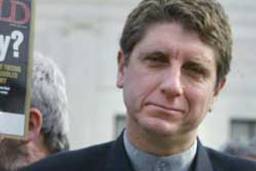Educate All Children
Adequate and equitable funding is required for schools to provide qualified teachers, small classes and up-to-date facilities
Barbara Miner

The right to a free, public education is enshrined in the constitutions of all 50 states. That right is under attack by the Bush administration and its allies.
Using the club of its shamelessly misnamed No Child Left Behind Act (NCLB), the Bush agenda punishes and sets up public schools for failure while promoting privatization schemes that funnel dollars to for-profit and religiously based programs.
At stake is not just the future of public education, but the very concept of a public sector that serves the common good. If public schools — in particular, urban schools — are decimated, can any other public institution survive the conservative privatization mania?
Because the Democrats share blame for the disastrous policies of NCLB, electing John Kerry will not guarantee progressive edu-cation policies. Nonetheless, defeating Bush is essential to checking the right-wing juggernaut and promoting policies essential to ensuring quality education for all, such as equitable funding, desegregation and smaller classes.
Bush has cloaked his toxic ideological mix of right-wing economic theory and religious zealotry under the mantle of “compassionate conserva-tism.” Using education as the prime example of his supposed concern for poor people, Bush poses his policies as an alternative to the Democrats’ “soft bigotry of low expectations.”
But the gulf between Bush’s rhetoric and reality is exemplified in NCLB, a cornerstone of his domestic agenda that entails a monumental shift in federal education policy. Opponents have labeled the act “No Child Left Untested.”
Proposed on January 22, 2001, two days after Bush took office, NCLB passed a year later in the heady months following 9/11 when Bush’s popularity was high. The bill effectively merged the privatization agenda of right-wing Republicans with the corporate-supported standardization and testing agenda of centrists in both parties. Backing by Democrats, including Kerry, ensured bipartisan support for what has become an albatross — some say noose — around the neck of public education.
Few in the country had even read the 1,100-page bill when it passed. But in the last two years, as its draconian measures have become clear, opposition has grown throughout the country’s 15,000 school districts and 95,000 public schools serving 48 million students.
NCLB is “like a Russian novel,” says Scott Howard, former superintendent in Perry, Ohio. “That’s because it’s long, it’s complicated and, in the end, everybody gets killed.”
The heart of NCLB is its monomaniacal obsession with standardized tests as the sole determinant of school success, and its trigger-happy willingness to label schools and entire districts as failures.
The act mandates that all students be “proficient” by the year 2014, a feat unprecedented in human history. To reach that impossible goal, NCLB requires schools to test 95 percent of all students in grades 3-8 every year in math and reading and at least once in high school. Test results are analyzed for nine subgroups, such as black students, special ed students and bilingual students. If even one of those subgroups fails to meet its mandated target, in even one of those tests, in even one of those grade levels, the entire school will not make “adequate yearly progress” and could be labeled a failing school. After two years, failing schools are subject to sanctions.
The seemingly benign bureaucratic term “adequate yearly progress” (AYP) has become a nightmare for schools. AYP most severely punishes low-income schools with students of color and bilingual students — those students who have fallen victim to the inherent biases of standardized tests since they were introduced a century ago. But AYP also traps more affluent suburban schools in its net. That, ultimately, could be its undoing.
In the first two years of NCLB, about 25 percent of the nation’s schools failed to make adequate yearly progress. In Florida, 88 percent of the schools were on the failing list. In California, home to roughly 13 percent of the nation’s public school students, officials estimate that 99 percent of the state’s schools will fail to meet progress requirements by 2014.
Not surprisingly, there is escalating concern that NCLB will be used to label all of public education a failure, thus paving the way for privatization via for-profit private management companies and vouchers for private and religious schools.
Sen. James Jeffords of Vermont, a former Republican who became an independent in large part because of the party’s hypocrisy on education, has called NCLB “a back door to anything that will let the private sector take over public education, something the Republicans have wanted for years.”
What makes the Bush agenda so dangerous is that it weds conservatives’ fever for privatization to fundamentalists’ devotion to religious education. Both groups see a chance to capture large chunks of the roughly $350 billion spent annually on K-12 public education.
Bush has left it to Secretary of Education Rod Paige to take the vanguard in denigrating public schools while extolling religious education. “All things being equal, I would prefer to have a child in a school that has a strong appreciation for Christian values where a child is taught to have a strong faith,” said Paige, according to the news service of the Southern Baptist Convention in April 2003. “In a religious environment, the value system is set. That’s not the case in a public school where there are so many kids with different values and different faiths.”
A quarter-century ago, Ronald Reagan launched the conservative counterrevolution with his winning mix of conservative economic policy and right-wing social agenda — and masking it all with warm and fuzzy rhetoric. Since then, hard-core Republican policies have gained strength and now dominate all three branches of government.
Breaking that right-wing Republican stranglehold is progressives’ absolute priority. At the same time, progressives must articulate clear alternatives to the lukewarm palliatives of many moderate Democrats. One area where Democrats have differentiated themselves from Republicans is their opposition to vouchers, a significant difference that is the educational equivalent of support for abortion rights when discussing women’s issues. The other basics of a truly progressive alternative are clear:
- Adequate and equitable funding so that all schools have the resources to provide qualified teachers, small classes and up-to-date facilities.
- High expectations and a rigorous curriculum for all students, not just middle-class kids on a college track.
- An end to the unconscionable segregation that is the hallmark of American education and that perpetuates our separate and unequal educational system — one for affluent, predominantly white suburban students and the other for poor, urban students of color.
- A commitment to free public preschool so all children enter first grade ready to learn and an equally strong commitment to access to higher education for poor students.
In the richest and most powerful country in the history of the world, is that too much to expect?
NOTE: This article was modifed on 08/09/04 to correct a change made during editing.






